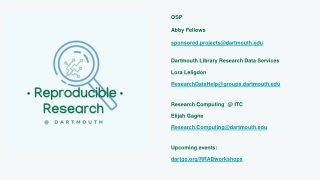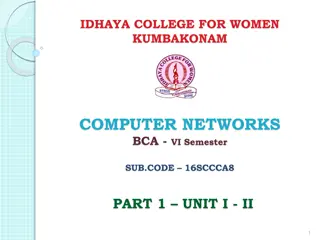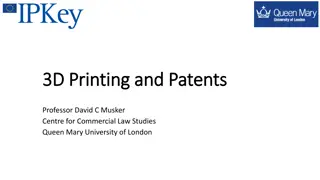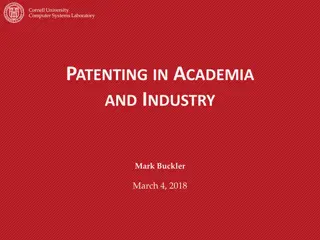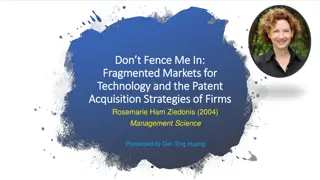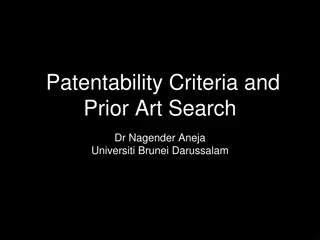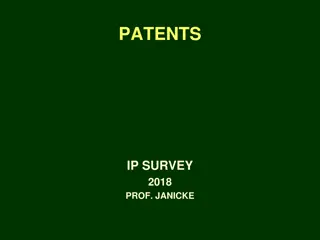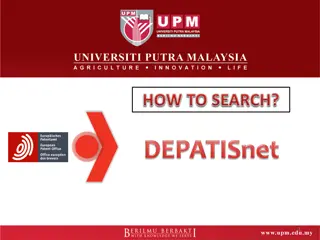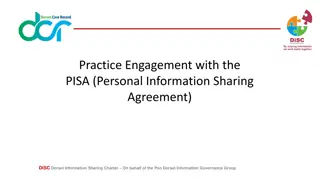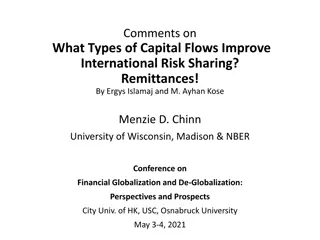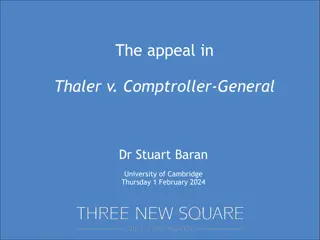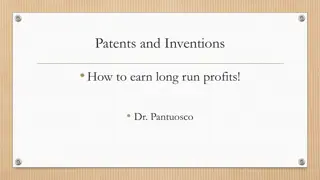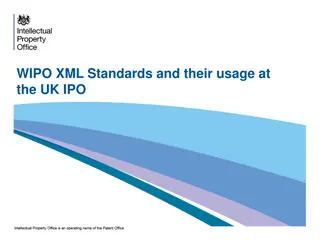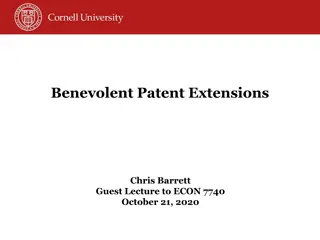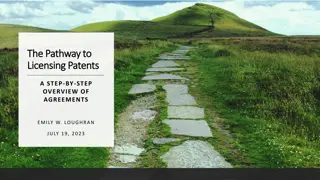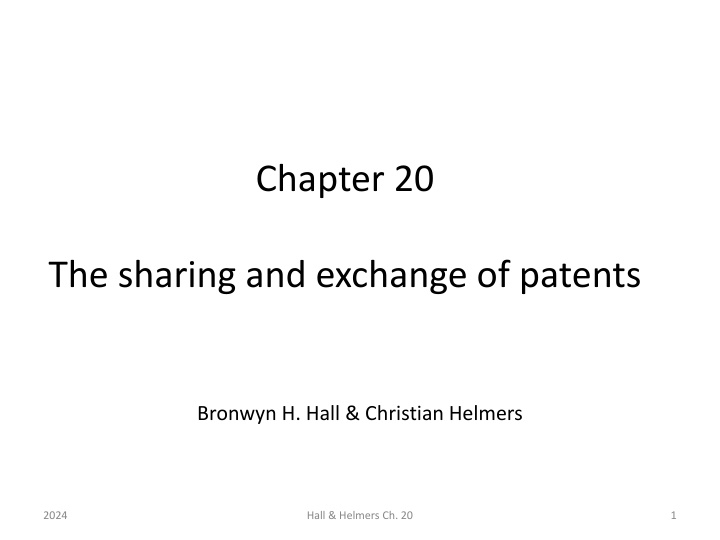
Sharing and Exchanging Patents in the Technology Market
Firms utilize various mechanisms to exchange patents, including licensing agreements, patent pools, and shared ownership. This market facilitates the redistribution of legal rights to patented inventions and other intellectual property. Explore the reasons why innovators share patents without payment and how it benefits society.
Download Presentation

Please find below an Image/Link to download the presentation.
The content on the website is provided AS IS for your information and personal use only. It may not be sold, licensed, or shared on other websites without obtaining consent from the author. If you encounter any issues during the download, it is possible that the publisher has removed the file from their server.
You are allowed to download the files provided on this website for personal or commercial use, subject to the condition that they are used lawfully. All files are the property of their respective owners.
The content on the website is provided AS IS for your information and personal use only. It may not be sold, licensed, or shared on other websites without obtaining consent from the author.
E N D
Presentation Transcript
Chapter 20 The sharing and exchange of patents Bronwyn H. Hall & Christian Helmers 2024 Hall & Helmers Ch. 20 1
Overview Introduction: How and why innovators share and exchange patents in the market for technology Licensing: tradeoff between revenue and rent- dissipation effects Patent pools Patent pledges and patent commons Patent sales Patent co-ownership 2024 Hall & Helmers Ch. 20 2
Introduction Firms routinely rely on a range of different mechanisms to share and exchange patents. Mechanisms include: (Cross-)licensing agreements, Patent pools, Patent pledges and patent commons, Outright acquisition of patents, Shared ownership of patents. Sharing and exchange of patents is part of what is referred to as the market for technology. Market for technology distributes and re-allocates the legal rights to the use of patented inventions. Encompasses other intellectual property rights and other forms of knowledge such as trade secrets or technical services. 2024 Hall & Helmers Ch. 20 3
Introduction Technology trade important for U.S. economy in terms of US$ paid and received in IP royalties and licensing fees. While U.S. has been running large trade deficit in tangible goods since mid-1970s, it registers a large surplus in market for technology. 2024 Hall & Helmers Ch. 20 4
Introduction Ability to exclude others from use of a patented technology main motivation for patenting. Why do firms voluntarily share patented technology with other firms, with or without receiving payment? Easy to explain when upstream innovators license to downstream manufacturers: Licensing allows the upstream innovator to monetize its invention without participating in product market. Downstream manufacturer can concentrate on manufacturing and selling the products that rely on patented technology. Enables specialization. Harder to explain why product market competitors share patents with each other: Sharing of patented technology can avoid duplication of research. Enable research collaboration and resolve conflict regarding patent infringement between competitors. Strategic and anticompetitive motivations. Some firms make their patented technology available to the public royalty-free. Sharing of patented technology produces significant benefits for society: Promotes diffusion of innovation. Increases returns to innovation by creating markets. 2024 Hall & Helmers Ch. 20 5
(Cross-)licensing Licensing by far most common way in which firms exchange patented technology. Licensing means owner of a patent retains ownership but grants another party right to use patented technology, usually in exchange for a licensing fee, or royalty. Different types of licenses: Sole license Exclusive license Non-exclusive license Cross-license Patent licensing mainly about legal right to use a patented technology. Licensing can involve transfer of know-how, important in situations where knowledge is more tacit and patents only disclose some but not all relevant aspects of a technology. 2024 Hall & Helmers Ch. 20 6
The economics of licensing Licensing allows patent holder to grant access to patented technology to one or potentially many third parties. Licensing enables vertical specialization in innovation : Allows innovators that lack necessary complementary assets to monetize inventions (Teece, 1986). Affects make or buy decisions that shape firm boundaries. Example: Dolby Laboratories, focus on upstream development of technology and license it to downstream consumer product manufacturers. Dolby licenses technology non-exclusively and at rates that provided little incentive for downstream manufacturers to invest in development of substitute technology (Sherman, 2018). 2024 Hall & Helmers Ch. 20 7
The economics of licensing Licensing affects product market competition: Access to patented technology can be barrier to market entry. Patent owner can control market structure and competition via licensing. Licensing affects speed and extent of technology diffusion: Licensing increases number of companies that can bring innovation to market. Broaden application of technology across different industries and geographical areas. Licensing also used for strategic and anticompetitive purposes: Incumbent licenses to less efficient entrant than other potential entrants (Rockett, 1990). Use of licensing to deter innovation by competitors. By offering to license existing technology, licensor can make licensing more attractive to other firms relative to having to invest in own R&D (Gallini, 1984). Second sourcing: company (Intel) agreed to license its technology to its direct rival (AMD). Establishing control over (de facto) standards. Licensing can be a necessity in technology areas where patent ownership is fragmented and patents are blocking access to technology components. 2024 Hall & Helmers Ch. 20 8
Determinants of licensing Determinants of licensing: Characteristics of patented invention: Type of technology (e.g. general purpose technology) Degree to which an innovation is embodied Degree to which invention is codified Extent of tacit knowledge involved Commercial uncertainty Market size Fragmentation of product markets 2024 Hall & Helmers Ch. 20 9
Modeling licensing decision Model of how interaction between upstream technology and downstream product markets affects firm s licensing decision (Arora and Fosfuri, 2003). Licensing has two opposed effects: Revenue effect: licensor earns direct income from licensing. Rent dissipation effect: licensor experiences erosion of profits as a result of licensing if licensee competes with licensor in product market. Firm licenses when revenue effect from licensing exceeds rent dissipation effect from creating competitors. When there are two or more independent potential licensors, licensing creates negative externality for other licensor in product market. Negative externality is ignored by each licensor. Privately profitable for each licensor to license, but joint profits would be higher in absence of licensing. 2024 Hall & Helmers Ch. 20 10
Modeling licensing decision 2 innovators i and j with patented technologies for production of a good. Both innovators vertically integrated. Many potential entrants that can only enter the market if they receive a license from one of the innovators. Entry does not involve any fixed costs. If entrants receive a license, they produce same good as licensor. Innovator i sells ki-1 non-exclusive licenses while innovator j sells kj-1 licenses, where i j. Licensing involves fixed cost F 0. Licensor obtains share [0,1] of profits earned by its licensee. Two-stage game: Stage 1: Competition in market for technology -- each innovator chooses how many licenses to sell to potential entrants. Stage 2: Competition in product market -- innovators and all entrants that obtained a license compete in product market. 2024 Hall & Helmers Ch. 20 11
Modeling licensing decision Stage 2: Licensors and licensees use technology to produce and compete in product market: Any company in product market makes ????,??,? , where ??? denotes degree of product differentiation between i and j with =[0,1], where =0 means independent products while =1 implies homogenous products. Assume profits decrease as products become more similar, i.e., ??? Using profits ????,??,? , each innovator s profits are: ( , , , , ) [1 ( 1)] ( , , ) ( i j i i j V k k F k k k = + ???< 0 and ??< 0. i i 1) k F i First part denotes total profits obtained from participating directly in product market and licensing income from all of i s licensees. Second part is sum of all transaction costs involved in i s licensing activity. 2024 Hall & Helmers Ch. 20 12
Modeling licensing decision Each innovator i chooses ki to maximize its profits. Corresponding first order condition: = + + i i i k [1 ( 1)] 0 V F k k i revenue effect rent dissipation effect ? is the derivative of i with respect to kigiven kj. where ?? Innovator s optimal choice of the number of licenses depends on two countervailing effects: Revenue effect: captures additional marginal licensing income of licensing to one or more entrants net of associated transaction costs. Rentdissipation effect: captures negative impact of adding another competitor to product market on all other firms that also compete in product market including licensor. 2024 Hall & Helmers Ch. 20 13
Modeling licensing income Equilibrium number of licenses ki* sold by licensor is defined by revenue effect and rent dissipation effect. 2024 Hall & Helmers Ch. 20 14
Modeling licensing decision Assuming 0, innovators i and j compete in product market. In equilibrium each firm chooses optimal number of licenses given its competitor s choice. Upward-sloping reaction curves. By licensing, each innovator externalizes part of cost associated with licensing to other innovator. In equilibrium, more licensing than in absence of externality and reduces aggregate industry profits. 2024 Hall & Helmers Ch. 20 15
Modeling licensing decision Predictions about optimal licensing: Transaction costs: Increases in transaction costs F induce firms to license less (k* is decreasing in F). Bargaining power: Increases in licensor's bargaining power induce firms to license more (k* is increasing in ). Product market competition: Licensing increases the more homogenous products sold by companies i and j (k* is increasing in ). Vertical integration: Innovators that are not vertically integrated license more. Upstream specialization: Presence of innovators that are not vertically integrated induces vertically integrated innovators to license more. 2024 Hall & Helmers Ch. 20 16
Determinants of licensing Empirical evidence is consistent with theoretical predictions: Survey-based evidence indicates that main motivation for firms to engage in licensing is revenue effect, i.e., main motivation is financial (Zuniga and Guellec, 2009). Evidence from PatVal Survey indicates that licensing decreases as transaction costs increase and that smaller firms license more since they have smaller market shares and are less likely to be vertically integrated (Gambardella et al., 2007). Firms in the chemical industry license more in markets where they have smaller market share (Fosfuri, 2006). Licensing decreases with increasing product market differentiation due to rent dissipation effect (Fosfuri, 2006). 2024 Hall & Helmers Ch. 20 17
Patent pools Wright brothers famous for pioneering achievements in aviation at beginning of the 20th century. Main innovation to achieve lateral stability during flight by twisting wings of an airplane in opposite directions ( wing warping ). Obtained a series of patents on their flying-machine which they aggressively enforced in court. Claimed patents covered any alternative technical solution to the problem of lateral stability. 2024 Hall & Helmers Ch. 20 18
Patent pools Wrights aggressive patent enforcement and steep royalty demands stymied airplane development in the U.S. U.S. entered World War I in 1917 - government struggled to find domestic airplanes fit for war service. Asst. Secretary of the Navy, Franklin D. Roosevelt urged Wright brothers and their competitors to pool their patents, make them available to each other either royalty-free or in exchange for modest fee. Pool covered 130 patents on aircraft structures at time of launch in 1917. Any future patents would be included in the pool and available royalty-free to pool members. Airplane patent pool ( Aircraft Manufacturers Association ) removed threat of litigation; enabled affordable access to inventions covered by patent rights owned by multiple parties. Pool lasted until 1975, disbanded as a result of a consent decree with the U.S. Department of Justice (DoJ). DoJ asserted that pool stifled competition in the airplane industry and hampered innovation. 2024 Hall & Helmers Ch. 20 19
Patent pools Patent pools have gained enormously in popularity since the days of the Wright brothers: Increase of the importance of technology standards and associated fragmented ownership of standard essential patents. Modern patent pools: MPEG , DVD, and Bluetooth. Recent surge in new patent pool formation in pharmaceuticals: Medicines patent pool, Pool for Open Innovation Against Neglected Tropical Diseases (NTD Pool), WHO COVID-19 Technology Access Pool. 2024 Hall & Helmers Ch. 20 20
Patent pools Patent pools are formal or informal set-ups where different companies pool their patents that are essential for a technology in order to license them to each other and possibly to outsiders. Voluntary organizations set-up and run by private organizations, the pool administrator. Firms choose whether to participate in a pool. Companies that have chosen to join a pool can often select patents that they want to contribute. In practice, most pools are incomplete , they do not include all relevant patent owners and members often do not contribute all relevant patents (Layne-Farrar and Lerner, 2011). 2024 Hall & Helmers Ch. 20 21
Medicines Patent Pool Medicines Patent Pool (MPP): non-profit organization created in 2010 by the global health initiative UNITAID. Goal: increase access to affordable life-saving drugs in low- and middle- income countries. Initially the MPP covered only HIV medication. In 2015, mandate expanded to include Hepatitis C and tuberculosis treatments and since 2018, it includes all drugs on the WHO essential medicine list. MPP negotiates non-exclusive licenses directly with originator companies. MPP sublicenses rights to generic pharmaceutical companies interested in manufacturing and selling generic versions in any of the countries covered by MPP licensing agreement. MPP negotiates licenses that can cover over 140 low- and middle income countries and licensees have to accept licenses with fixed geographic scope. Majority of licenses are royalty free and if they involve royalty payments, the royalty is low, typically capped at 5% of total revenue. 2024 Hall & Helmers Ch. 20 22
Medicines Patent Pool Empirical evidence (Galasso and Schankerman, 2021; Wang, 2022): Increase in probability of licensing to generic manufacturers of a drug contributed to MPP of 73 percentage points. 7 percentage point increase in share of generic purchases in developing countries. But only 3 percentage point increase of probability of launch of generic versions in developing countries. Longer delay until launch occurs, presumably because pool insiders become less active in those countries. Gap between potential launch (licensing) and actual launch is due to the fact that generics have to accept a bundle license which includes markets where launch is not profitable. Due to non-exclusive licensing, there is also risk of excessive market entry. Positive impact on follow-on innovation by pool outsiders. Evidence suggests increased availability of generic drugs at lower prices as a result of patent pool. Unclear to what extent increased licensing is driven by lower transaction costs induced by pooling of patented drugs or rather by overall lower licensing fees negotiated by the MPP. 2024 Hall & Helmers Ch. 20 23
Patent pools Patent pools have a number of benefits for both licensors and licensees: With fragmented patent ownership, pool reduces transaction costs associated with licensing. Avoid tragedy of the anti-commons (Heller and Eisenberg, 1998). Avoid royalty stacking. Reduce risk of litigation. Reduce asymmetric information - an objective third party conducts patent checks before patents enter pool. Promote technology adoption and diffusion. 2024 Hall & Helmers Ch. 20 24
Patent pools Patent pools can reduce competition between pool members: Typically, members of the same pool are also product market competitors, upstream or downstream. Anticompetitive effects depend on relationship between the patents contributed by different members. If patents are substitutes, a pool reduces competition. If patents are complements, a pool is unlikely to reduce competition. Pool members can extend collaboration outside of pool to set prices collusively in product market. Pool members can favor pool members at the expense of entrants and restrict licensing to outsiders. 2024 Hall & Helmers Ch. 20 25
Patent pools Process of pool formation often complex. Pools often form gradually, with one or several core members establishing the pool for then other companies to join over time. This means that usually some patent holders remain outside of a pool and license individually instead. Example: Thomson decided not to join the two DVD patent pools and instead chose to license independently. 2024 Hall & Helmers Ch. 20 26
HEVC patent pools High Efficiency Video Coding (HEVC): video compression technology. Standard created by Joint Collaborative Team on Video Coding, formed in 2013 through collaboration of several standard setting organizations. HEVC technology is protected by a large number of SEPs held by many different companies. Until recently, three patent pools offered HEVC licenses: (1) MPEG LA, (2) HEVC Advance, and (3) Velos Media (closed). Many companies that have chosen not to join a pool and instead license their HEVC SEPs independently. Co-existence of several pools combined with the independent licensing of several large players in the HEVC technology market creates a complex licensing landscape. Hall & Helmers Ch. 20 2024 27
Patent pools Effect of patent pool depends on its set-up : Price for a pool license. Rules governing licensing among pool members since normally contributions by pool members differ both in quantity and value. How to divide licensing income when pools license to outsiders: Adopt sharing rule. Licensing payments may be a simple function of the number of contributed patents. Take into account differences in technological importance among patents. Rules affect transaction costs, more complex rules more difficult to negotiate and to administer. Rules depend on whether pool members are allowed to license independently patents they contributed to the pool. Individual contributions: Contribute all of the patents in a relevant technology. Contribute only subset and license the rest independently. Pools also have to decide how to handle future patenting by pool members: Grantback clauses. Adjustment clauses. 2024 Hall & Helmers Ch. 20 28
Patent pools: empirical evidence Evidence from sewing machines patent pool (Lampe and Moser, 2010, 2013): Pool had a negative effect on innovation and patenting, especially for its members. Pool affected non-members by increasing risk of litigation, thereby discouraging innovation by outsiders. Weakened competition for members, which reduced their incentives to innovate. Outsiders encouraged to switch to inferior substitute technologies that were not covered by the pool. Evidence from pools formed in a diverse set of industries during the 1930s confirms that pooling of patents on substitute technologies reduces competition between pool members which reduced incentives to improve pool technology (Lampe and Moser, 2016). Evidence on modern patent pools (MPEG and DVD patent pools) suggests patent pool formation had a negative impact on innovation (Joshi and Nerkar, 2011). 2024 Hall & Helmers Ch. 20 29
Patent pledges In 2014, Tesla Motor s CEO Elon Musk publicly announced that Tesla would not enforce any of its patents against any third parties. Tesla s announcement is an example of a patent pledge. Patent pledges are public, irrevocable commitments by companies not to enforce their enforceable patents against anyone that meets certain conditions. Musk stated that the pledge applied to anyone who, in good faith, wants to use Tesla s technology. Pledge subject to certain conditions, including refraining from the assertion of any type of IP against Tesla or against a third party for its use of technologies relating to electric vehicles or related equipment and refraining from challenging validity of any of Tesla s patents. 2024 Hall & Helmers Ch. 20 30
Patent pledges: characteristics Accessibility: open to the public or restricted to specific types of technology users. Tesla s pledge is open to the public. Toyota s pledge of patents on hydrogen fuel cell and vehicle electrification technologies is restricted and users have to negotiate individual royalty-free license agreements with Toyota. Include specific set of patents or blanket declarations concerning all patents on a given technology or all patents held by a given company. Tesla s pledge is a blanket declaration concerning all patents on a given technology . Ability to revoke pledge or transfer pledged patent without requiring the buyer to adhere to the pledge. Tesla s pledge states that any patent buyer has to provide the same protection that Tesla provided under the Pledge and to place the same requirement on any subsequent transferee . 2024 Hall & Helmers Ch. 20 31
Patent pledges: motivation Many companies make patent pledges, especially in open source software industry (e.g. Sun, Red Hat, Google). Patent holder benefits more from promoting use of patented technology by setting price of a license to zero than from maximizing licensing revenue or preventing any third party use. Why do for-profit companies pledge not to assert their patents while still incurring the full cost of their maintenance? Product interoperability through common technology standards. Promotion of technology platforms. Sales of complementary products or services. Wider corporate social responsibility objectives including mitigating climate change (Contreras, 2023). 2024 Hall & Helmers Ch. 20 32
Patent commons In 2008, IBM together with Nokia, Pitney Bowes, and Sony launched the Eco-Patent-Commons (EcoPC): 13 companies contributed a total of 248 patents to the commons. Patents covered environmentally friendly technology. Example, IBM pledged a patent that covered recyclable cardboard packaging for electronic components. Commons wanted to promote the adoption of patented green technologies and facilitate follow-on innovation. Since patented technologies already visible to the public, goals would be achieved by publicly committing not to assert the patents. EcoPC is a patent commons since it assembles patent pledges from different companies. EcoPC shared all of the characteristics of patent pledges: public irrevocable commitment not to assert against any third party that meets certain conditions. 2024 Hall & Helmers Ch. 20 33
Patent commons Patent commons are different from cross-licensing agreements or patent pools: Patent commons are open to third parties, i.e. subject to certain limitations, anyone can use the technology covered by patents that have been placed in the commons. Often no formal contract needed to benefit from the pledged patents; often users do not even have to notify the patent owners of their use. Cross-licensing arrangements only apply to participants of licensing agreement. In patent pools, patents are only shared among contributing members. Some pools also grant access to outsiders against payment of licensing fees. In any case, they require an explicit licensing agreement between licensor and licensee. 2024 Hall & Helmers Ch. 20 34
Patent commons The reason patent commons exist are similar to those that motivate individual companies to make patent pledges. Many other patent commons: Patent Commons Project created by the Linux Foundation to help protect the open source Linux ecosystem. Covid Patent Commons: access to patents covering technology relevant for combating the Covid pandemic Impact of patent commons: EcoPC had no impact on follow-on innovation that was indeed based on the patented technology (Contreras et al., 2019). Interviews with stakeholders involved in EcoPC point to a number of specific problems with the set-up of the EcoPC, which contributed to limited impact. Evidence from a much broader set of patent pledges suggests that pledges can spur follow-on innovation, although there is substantial heterogeneity depending on characteristics of patent pledges, pledging firms, and pledged patents (de Rassenfosse and Palangkaraya, 2023). 2024 Hall & Helmers Ch. 20 35
Sale of patents Patent owners buy and sell patents outright, which means a transfer of patent ownership. Transfer of ownership interest of a patent right distinguishes the sale of a patent from licensing since licensing merely involves permission by patent owner for the use of a patented invention. Reasons for sale or acquisition of patents are similar to those that motivate licensing. Key difference between selling and licensing of patents is that sale of a patent does not create a rent dissipation effect since no additional competitor is created. 2024 Hall & Helmers Ch. 20 36
Sale of patents Situations where firms prefer to outright buy or sell a patent instead of licensing it: Company exits a certain market segment and has no more use for any associated patents. Innovation turns out to have a different use than anticipated. Innovator lacks necessary complementary assets. Commercial success of technology is lower than expected. Company goes bankrupt and all remaining assets are liquidated. Non-practicing entity (NPE) business model. Enter new markets and overcome patent blockage. Gain freedom to operate, e.g., by enabling cross-licensing agreements. Deterring entry of new competitors. Ability to trade patents as standalone assets has also indirect benefits: Promotes access to external financing for firms. Patents can be used as collateral for a loan from a financial institution. Promotes investment in early-stage ventures since they allow investors to recoup part of their investment in case of bankruptcy. 2024 Hall & Helmers Ch. 20 37
Sale of patents In practice, patents are bought and sold either privately, directly between buyers and sellers, or through a quasi-public brokered market (Love et al., 2018). In the brokered market, patents available for sale are visible to market participants, and there are different entities that facilitate the sale of patents: Patent brokers (e.g. ICAP Patent Brokerage, Vitek IP) Online marketplaces (e.g. IAM Market), Auction houses (e.g. Ocean Tomo). Important distinction between brokered and private market for patents: In brokered market, participants often have access to information on patents for sale, buyers, and prices. In private market, no information disclosed to outside parties, although patent re-assignment data will still reveal that a transaction has taken place. 2024 Hall & Helmers Ch. 20 38
Sale of patents Patent sales have increased over time (De Marco et al., 2017). Traded patents are much more valuable than untraded patents (Serrano, 2018). On average only small fraction of the difference in value is attributable to the trade itself. Distribution of patent value due to trade highly skewed with a small share of patents accounting for the bulk of the gains from trade (Serrano, 2018). Small firms sell a higher share of their recently granted patents than large firms (Figueroa and Serrano, 2019). Firms sell patents that are more technologically distant to the selling firm s patent portfolio (Akcigit et al., 2016). Patents that are bought are more similar to the buying firm s than the selling firm s patent portfolio (Akcigit et al., 2016). Market for patents plays an important role in the reallocation of inventions to firms that are better placed to use and monetize them. Important argument in favor of patent system because patents enable legal transfer of ownership of an invention by turning invention into a tradeable asset (Spulber, 2015). 2024 Hall & Helmers Ch. 20 39
Co-ownership Co-ownership of patents often result of joint research activities. Firms engage in joint research for a number of reasons: Pool knowledge and expertise if they possess complementary knowledge. Reduce risk associated with the research process. Scale economies. Internalize spillovers associated with research. Ample empirical evidence that joint research allows companies to generate more valuable innovation. 2024 Hall & Helmers Ch. 20 40
Co-ownership How to appropriate returns to joint research and how to distribute returns? Parties have to make these decisions before they know the outcome or value of their joint research. Affect parties willingness to engage in collaboration and effort provision during collaboration. Solution: agree ex ante to sharing the ownership of the patent that protects the outcome of joint research. Co-ownership can help maximize incentives for all parties involved to invest in joint research (Schmitz, 2017). But co-ownership can also limit ability of co-owners to appropriate returns to joint invention. Around 1% of patents are co-owned by independent companies (Hagedoorn, 2003). Co-owned patents are associated with higher forward citation counts than individually owned patents (Belderbos et al., 2014). 2024 Hall & Helmers Ch. 20 41
Co-ownership Co-owners have equal rights to the use of the patented invention without regard to their individual contribution. Degree to which co-ownership affects appropriation depends on the product market relationship between co-owners. If co-owners are direct product market competitors, co- ownership implies that firms will compete in the product market. The result is a duopoly rather than a monopoly with joint profits being lower than the profits obtained by a monopolist. 2024 Hall & Helmers Ch. 20 42
Co-ownership Depending on the jurisdiction, joint ownership also imposes restrictions on licensing of the co-owned patent: In most European countries, including Germany and France, co-owners have to agree to the licensing of the patent by any of the co-owners. In other jurisdictions, such as the U.S., co-owners are free to license non-exclusively or sell co-owned patent without consent from other co-owners. Co-ownership creates trade-off between lack of control over the licensing/sale by different owners and increased incentives to contribute to joint research (Fosfuri et al. 2017): Trade-off is more pronounced the closer co-owners compete in the product market. In legal systems where co-owners can freely license without the consent of the other co-owners, co-owners have incentives to over- license . 2024 Hall & Helmers Ch. 20 43
Summary Companies routinely share patents using a range of different mechanisms. Resulting market for patents and licenses increases incentives to innovate. But sharing of patents also creates opportunities for strategic and outright anti- competitive behavior. Enormous growth in licensing and the trading of patents over recent years. Market for patents is inefficient: Relatively few licensors and licensees for a given patent. Asymmetric information and uncertainty over value and validity of any given patent and need to trade patent packages rather than individual patents. Lack of price transparency since most patent transactions are not observable by public. Absence of thick markets and lack of transparency creates room for strategic behavior. Market-based solution (e.g. public patent auctions) not at scale to make material difference. Many patents that could be traded currently not traded which leaves substantial room for further growth of the market for technology. 2024 Hall & Helmers Ch. 20 44

